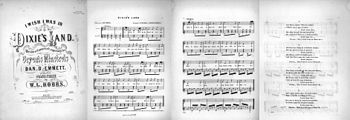Dixie: Difference between revisions
No edit summary |
|||
| Line 1: | Line 1: | ||
{{otheruses}} |
{{otheruses}} |
||
[[Image:DixBankNote.jpg|thumb|290px|right|Ten Dollar Note from ''Banque Des Citoyens'' of Louisiana, [[1860]]]] |
[[Image:DixBankNote.jpg|thumb|290px|right|Ten Dollar Note from ''Banque Des Citoyens'' of [[Louisiana]], [[1860]]]] |
||
'''''Dixie''''' is a nickname for the [[Southern United States]]. |
'''''Dixie''''' is a nickname for the [[Southern United States]]. |
||
== Origin of ''Dixie'' == |
== Origin of ''Dixie'' == |
||
Revision as of 23:31, 17 September 2007

Dixie is a nickname for the Southern United States.
Origin of Dixie
According to the Oxford English Dictionary, the origins of this nickname remain obscure. According to A Dictionary of Americanisms on Historical Principles (1951), by Mitford M. Mathews, three theories most commonly attempt to explain the term:
- The word "Dixie" refers to a privately issued currency from banks in Louisiana[1]. These banks issued ten-dollar notes, labeled "Dix" (French for "ten") on the reverse side. These notes are now highly sought-after for their numismatic value. The notes were known as "Dixies" by English-speaking southerners, and the area around New Orleans and the Cajun-speaking parts of Louisiana came to be known as "Dixieland". Eventually, usage of the term broadened to refer to most of the Southern States.
- The word preserves the name of a kind slave owner on Manhattan Island, a Mr. Dixy. (Slavery was legal in New York until 1827.) His rule was so kindly that "Dixy's Land" became famed far and wide as an Elysium abounding in material comforts.
- "Dixie" derives from Jeremiah Dixon of the Mason-Dixon line defining the boundary between Maryland and Pennsylvania (the northern boundary of Dixie).
The Mason-Dixon theory is the most popularly known, but few lexicographers give it much weight[citation needed].
I Wish I Was in Dixie
- Main article: "Dixie (song)"

"I Wish I Was in Dixie" is a popular song about the South. It was written by composer Daniel Emmett, a Northerner, and published in 1859. A blackface minstrel-show troupe debuted the song that same year in New York City. As with other minstrel show numbers, the song was performed in blackface and in exaggerated Black English Vernacular. The song proved extremely popular and became widely known simply as "Dixie". The song has also been published as "Dixie's Land".
The song became the unofficial anthem of the Confederate States of America during the American Civil War. This and the tune's minstrel-show origins have created a strong association of "Dixie" with the Old South. As a result, some today view the song as offensive and racist.
Dixie as a region
As a definite geographic location within the United States, "Dixie" is usually defined as the 11 Southern states which seceded to form the Confederate States of America. They are (in order of secession): South Carolina, Mississippi, Florida, Alabama, Georgia, Louisiana, Texas, Virginia, Arkansas, Tennessee, and North Carolina. This definition is strongly correlated with history and, in the minds of many Southerners, remains the traditional and emotional South.
In other ways however, the "location" and boundaries of Dixie has become, over time, more limited, vernacular, and/or mercurial. In popular mindset today, it is most often associated with those parts of the Southern United States where Old South traditions and legacies of the Confederacy live most strongly, and are most widely celebrated and remembered. Or where the image of "moonlight and magnolias" is very rooted in reality.
In this particular contemporary realm, there are no hard and fast lines. Roughly however, it might be an area which begins in southern Virginia and extends south into the Florida panhandle. On the northern boundary it sweeps west to take in Tennessee (and perhaps the southern parts of Kentucky), then westward through a good part of Arkansas. On the southern end it would run through the Gulf states until the northern and southern boundary lines connect to include and take in East Texas.
Many businesses in the South contain "Dixie" in their name as an identifier, e.g. "Dixie Produce." One of the more famous is supermarket chain Winn-Dixie. Related to this fact, renowned cultural sociologist and "Southernologist" Dr. John Shelton Reed has attempted to "locate" Dixie by a criterion measuring the ratio of business listings containing the term as compared to those utilizing "American." First published in a 1976 article in Social Forces, this particular study was later updated in 1988. In contrasting the two, the delineating lines measuring over 6% of Dixie to American remained fairly constant in covering the Old Confederate States, with the exception being in Texas where, in both surveys, it was fairly well limited to eastern parts of the state.
Noted anomalies were the inclusion, and later even slight extension, into parts of the lower Midwest, particularly southern Indiana and southwestern Ohio. Neither of these areas can be properly considered a part of the South, so one explanation could be the extent of the so-called "Dixie Highway" into those particular locales and business names reflecting such.
In using a yardstick of 15%, all but a tiny slice of northeast Texas drops out of the picture. Also losing considerable ground were Virginia and most of Florida save the panhandle. Notable losses also occurred in North Carolina and Kentucky. Most remarkable of all however, was, as Reed stated, the fact that Dixie "dissolves as a coherent region" when the even more demanding standard of 25% was applied. In 1988 as compared to 1976, with the exception of small and isolated parts of adjoining states, only in Mississippi, Georgia, and South Carolina were large areas still recorded on the data map.
The first 10 notes of Dixie are the opener on The Dukes Of Hazzard. Also, they are the horn of The General Lee.
See also
Songs
References
- John Shelton Reed (with J. Kohl and C. Hanchette) (1990). The Shrinking South and the Dissolution of Dixie. Social Forces. pp. 69 (September 1990): 221-233.
{{cite book}}: Check date values in:|year=(help)CS1 maint: year (link)

